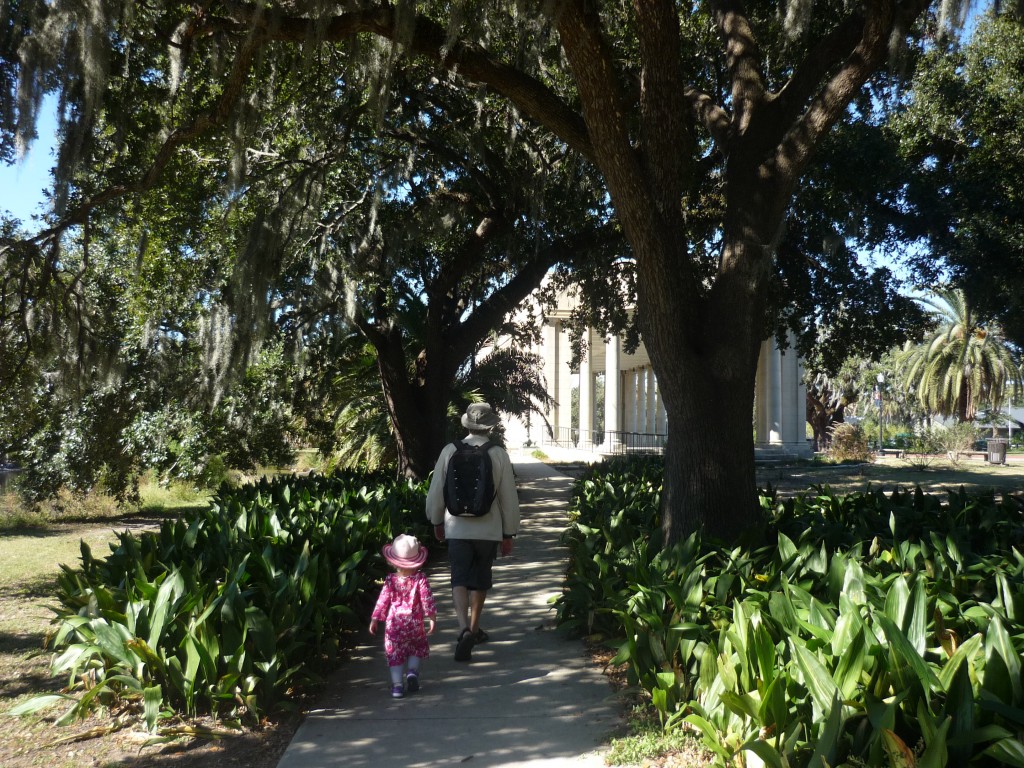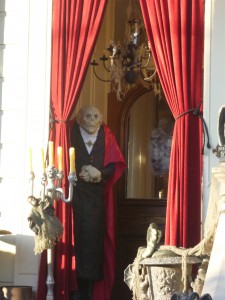Cross-posted from After Katrina: A View From the Outside, 18//4/14
Dr Anna Hartnell, Lecturer in Contemporary Literature, Birkbeck College, University of London
 A series of reports this week are showing that many UK school children and their teachers are exhausted, over-worked by an economy and political context that fails to support workers, families, or the flourishing of those little people who are already born into a world over-shadowed by the carelessness, greed and the general over-reaching of a generation who showed little regard for the future of the next. No doubt like many parents, I watched these reports feeling vaguely complicit, totting up the weekly hours that my not-yet-three year old currently spends in childcare: 32. Not quite a full-time job but nearly there. As an academic I have the luxury of flexible working hours that means I can see a little more of my child if I am prepared to work most evenings and sometimes long hours into the night. This arrangement can make me feel a little ghostly at times, but I am privileged to have a choice not open to most.
A series of reports this week are showing that many UK school children and their teachers are exhausted, over-worked by an economy and political context that fails to support workers, families, or the flourishing of those little people who are already born into a world over-shadowed by the carelessness, greed and the general over-reaching of a generation who showed little regard for the future of the next. No doubt like many parents, I watched these reports feeling vaguely complicit, totting up the weekly hours that my not-yet-three year old currently spends in childcare: 32. Not quite a full-time job but nearly there. As an academic I have the luxury of flexible working hours that means I can see a little more of my child if I am prepared to work most evenings and sometimes long hours into the night. This arrangement can make me feel a little ghostly at times, but I am privileged to have a choice not open to most.
Some irritating TV reporting wanted to turn this bold and important statement by the Association of Teachers and Lecturers into ‘another way to make parents feel guilty’. But as representatives of the teachers’ union repeatedly stated, this report is an indictment not of over-worked parents but rather the social and political context that shapes the conditions of precarity that govern most working families’ lives, wherein wages are decreasing in real terms while the cost of food and rents rise. Redundancies loom on the horizon. And the rich get richer.
These reflections on our time-poor worlds intersect with some current work I’m doing on notions of temporality in New Orleans, and specifically the idea that in the City that Care Forgot, time is there in abundance. This is of course in large part a packaged, commodified sense of time offered up by a tourist industry serviced by over-worked and underpaid ghosts. Ghostly in more ways than one – until Katrina ‘opened up’ the city (in profoundly ambivalent ways) these workers resided in neighbourhoods all-but-invisible to visitors to the city huddled in the historic parts of town that line the Mississippi River. In tourist areas, especially the French Quarter, time is wound back for the visitor who is encouraged to imagine themselves into the leisured existences of the nineteenth century (white) Creoles or simply partake of the pleasures – largely alcohol and sex – that have since the nineteenth century been on offer in thoroughfares like Bourbon Street. By the 1940s, the city’s boosters had realized that there was serious money to be made by promoting New Orleans as in a charming but terminal state of decline, an ambience that might provide an ideal respite from the relentless drive of the ‘American Century’, where notions of progress, capitalist enterprise, and above all, work, defined the social and political context of postwar US families.
It goes without saying that this vision of New Orleans is as much a mirage as the myths that fuelled the idea of the ‘American Century’. People in New Orleans work hard, and are exploited as they are elsewhere. The idea that this ‘Caribbean city’ is somehow inefficient is part of a racialized stereotype that afflicts many service economies where the majority of inhabitants, and indeed workers, are non-white.
And yet one can’t help feeling that there is something real, and indeed transgressive – if ultimately elusive – behind the designation ‘New Orleans time’. On one of my last days in the city in December, I found myself sitting on a parked streetcar – the driver had just darted off into the nearest shop to get herself a drink. She was thirsty, she told the carriage. As a Londoner, where train companies face financial penalties if they don’t run on time, I was a little amazed. Good-naturedly (it seemed to me), the other passengers awaited her return (while I tried to suppress my irritation and enjoy the moment: I was late for a meeting). After recounting the story to a friend of mine she commented: ‘that’s the old New Orleans – I didn’t imagine that kind of thing happened anymore.’ She was referring to the sense that the post-Katrina gentrification, the wave of transplants who have invaded the city with money and education and ‘social capital’ – pushing out many long-time residents in the process – have irrevocably changed the city’s cultural landscape, making it less distinctive, more like anywhere else in the United States. The irony is of course that many of these people came because they wanted to help the city get back on its feet, and stayed because they too were pulled in by the lure of ‘New Orleans time’.
The city’s annual calendar of festivities is enough to indicate that there is indeed a different way of experiencing time in this city. Mardi Gras and Jazz Fest bring in enormous revenues, not least because they are major tourist attractions. But it would be foolish to suggest that these events hold no appeal for locals of all stripes, even if, like Mardi Gras, they incubate troubled racial histories. And these are only the most prominent events in a year-long calendar that insists on the need to regularly take ‘time out’. The weekly newsletter issued by my daughter’s nursery without fail listed at least a couple of festivals taking place at the weekend – local, outdoor events typically combining music and food, hosted by local church, musical or cultural groupings and, it seemed to me, attended largely by locals. All cities host festivals of various kinds, but New Orleans is particularly committed to events that celebrate public space.
The Second Line is perhaps the most prominent way in which the city collectively underscores the importance of street life. Almost every Sunday, with the exception of the hottest weeks of the year, a social aid and pleasure club accompanied by a brass band dances out into a particular neighbourhood, accumulating followers as it makes its way through the streets. Though Second Lines are particularly vulnerable to hijacking by tourists and transplants, their roots in historically black neighbourhoods highlight their trajectory as grassroots cultural institutions that have bubbled up from the streets, as opposed to top-down spectacles created for tourists. As Helen Regis has shown, these parades represent the reclamation of city streets from a rhetoric that has overwhelmingly associated black neighbourhoods and the city in general with crime.
New Orleans has in many ways followed the trajectory of many US cities in the second part of the twentieth century, suffering white flight and the loss of a tax base, leading to a decaying and majority-black urban core surrounded by mostly white, affluent suburbs. And yet the sheer magic that has arisen from New Orleans’ streets means that its culture is still celebrated – if constantly fetishized and coopted. The focus on preservation and tourism meant that the French Quarter was spared the proposed freeway that would have blocked access to the Mississippi River. The city’s historic legacy means that there is still a strong orientation to what is often seen as its ‘spiritual core’ towards the river, despite the environmentally hazardous draining of the backswamp in the twentieth century that dramatically expanded the city lakewards and contributed to LA-style sprawl.
That said, New Orleans is still a car culture, with all the emphasis on privatized space that this entails. Having grown up in London, I never learned to drive. On arrival in New Orleans, this quirk was largely smiled at: New Orleans is a great city to walk around, everybody told me. But, with shadows forming around the face, it does get really hot here, and when it rains… These anxieties were well-founded. No city is fun to walk around without a fully functioning public transportation system to shift the distances or shelter you from inhospitable weather. And though I have never enjoyed walking through city streets as much as I have in New Orleans – those oak corridors in the Garden District, the lace balconies of the French Quarter, can be breath-taking – the sidewalks were not designed with pushchairs in mind. In fact, as I soon realized, in a car culture, ‘stroller’ – the US term – really is the right word for what I call a ‘buggy’. It’s not about getting from a to b, but rather ‘strolling’ between car hops. And it became clear to me while in New Orleans that these vehicles are the sign of the wealthy: I did an almost daily commute on the city’s maddeningly infrequent buses between my daughter’s nursery and home. Not once did I see another buggy – an object that now by law has to be collapsed on a New Orleans bus, and which is still in everybody’s way. A clunky indulgence, seemed to be the general view. An oddity in itself that made me wonder how all the mother’s with babies and toddlers in arms on the bus could get around.
If the freeway can be seen as one of the signs of US modernity in the latter part of the twentieth century, then New Orleans has in part resisted this version of the ‘modern’, along with the obsession with time-keeping that goes hand in hand with an administered world in which people move swiftly between the home, the school, and the workplace in the individualized space of the car. Its twentieth century suburban developments alongside its celebrations of street culture and valued inner core show New Orleans to be a battleground between a Robert Moses-style planner and a Jane Jacobs-style urbanite, the one privileging the car, the other the pedestrian.
 New Orleans’ suburban orientations were particularly apparent at Halloween. Given its privileging of the festival and the prominence of the gothic and indeed the dead in the city, it is no surprise that by mid-October, New Orleans’ buildings are draped in spiders and the windows peopled by frightening mannequins. As I explored some of the more elaborate Halloween displays in Uptown, it became clearer to me that this had become in some respects a suburban festival which quite rightly and ironically identifies the deeply unhomely qualities of the home. Single-lot houses bedecked in Halloween paraphernalia – warning against and warding off entry into the home – seemed to quietly suggest that fears of the street are in part projections of something emanating from the inside.
New Orleans’ suburban orientations were particularly apparent at Halloween. Given its privileging of the festival and the prominence of the gothic and indeed the dead in the city, it is no surprise that by mid-October, New Orleans’ buildings are draped in spiders and the windows peopled by frightening mannequins. As I explored some of the more elaborate Halloween displays in Uptown, it became clearer to me that this had become in some respects a suburban festival which quite rightly and ironically identifies the deeply unhomely qualities of the home. Single-lot houses bedecked in Halloween paraphernalia – warning against and warding off entry into the home – seemed to quietly suggest that fears of the street are in part projections of something emanating from the inside.
Suburbanization is partly responsible for making city spaces, in feel and in reality, unsafe. As Jane Jacobs reminds us, ‘eyes on the street’ can play their part in policing crime. The deserted streets of the feared inner city mirror the deserted streets of the car-dominated suburbs. New Orleans, notorious as a murder capital in the 1980s and 90s and still plagued by high crime rates, is no exception. Apart from the French Quarter, which teems with people for 24 hours a day, New Orleans’ streets are very quiet after dark, and a number of taxi drivers have picked me up from bus stops – after ridiculously long waits – in horror at my stupidity for being on them alone. After Katrina, public transportation in the city was scaled back, the city’s only free hospital shut down, public housing demolished, the city’s school system largely privatized. The ‘right to the city’ has been seriously curtailed.
And yet a different attitude to the notion of the public, the street, and to time, lives on. Carol Bebelle, founder and director of Central City’s Ashé Cultural Arts Center, eloquently summed this up for me in an interview. She was trying to explain why, in her view, New Orleans ‘is not like anyplace else.’ ‘It begins with the process of bonding,’ she said. If you ride the – admittedly infrequent – public transportation system for a month here, she explained, and then disappeared, people would wonder where you had gone. ‘You can make a community on the bus, in church … once you have established the pattern of being together.’ Bebelle was referring to something I had experienced: those long awaited buses – and well-populated bus stops (at least in the day time) – were full of people who wanted to pass the time of day. By the end of our three months in the city, my daughter and I had indeed built up a ‘community’ of people that we regularly talked to during our daily commute.
Talking of the qualities which attract newcomers to the city, Bebelle explained: ‘there is something about living an authentic life, where you have a human connection, which essentially outweighs a bunch of other things that folks might think are really more valuable.’ What Bebelle was describing was a set of cultural rituals – that encompass but go far beyond rituals like the Second Line – that transcend market values. Bebelle suggested that this difference can be explained by African and Caribbean traditions that live on in this city through ‘the dance of dialogue, the dance of connection, which is present all the time’ and speculated that such characteristics can be found ‘in indigenous people wherever you find them.’
This is the rooted aspect of many New Orleans neighbourhoods that has been threatened, but not altogether destroyed, by the upheavals following Katrina, the neoliberal assault on public life. One of the many ironies that attends the post-Katrina city is that ultimately, if the centralized, Jane Jacobs-style pedestrian city has partially won out, it is now wide open to gentrification fuelled by the slogans about the very ‘mixed-use’ accommodation Jacobs championed, which sounds good in theory but which in practice typically drives out low-income families. The re-occupation of city centres across the US, and particularly in New Orleans, is underway.
US-style anti-urbanism is largely foreign to the European setting, and yet it is likewise a relatively recent scenario that has made places like central London unaffordable for all but the privileged few. That said, we still have an idea of the public commons and a social safety net which means that those looking after young children in the city can do a host of activities for free. One O’clock clubs, the embattled Sure Start Centres, still run invaluable programmes, in contrast to New Orleans, where it seems that few activities specifically designed for children come free from a commercial context. The local toyshop put on lots of great events, but even if the parent can resist the pressure to buy at the end of it they will likely be faced with a tantrum. And New Orleans’ Children’s Museum is a wonderful place to play, if you can afford the entrance fee, cope with the branding (the model supermarket is a Winn Dixie’s) and stomach the emergence in December of Christmas trees proudly adorned with objects produced by Louisiana’s petrochemical industries (responsible for the stretch of the Mississippi – between New Orleans and Baton Rouge – known as ‘Cancer Alley’).
And yet it is clear that in spite of the commercial assault, in spite of the fact that many Charter Schools are doing their best to create a generation of ghost children, a different order of priorities still circulates in the Crescent City. In the context of nearly 50% unemployment among African American men, who often reside in parts of the city that, like much of urban America, have in the last part of the twentieth century been devastated by the overseas outsourcing of manufacturing jobs, it’s important not to romanticize ‘time out’ from work. But it is remarkable that under such difficult circumstances, pockets of New Orleans sustain community rituals that don’t just transcend but also challenge market values. These rituals represent priorities that the over-worked zombies who fly around the very efficient mass transit system here in London might look to, if they weren’t so exhausted.
